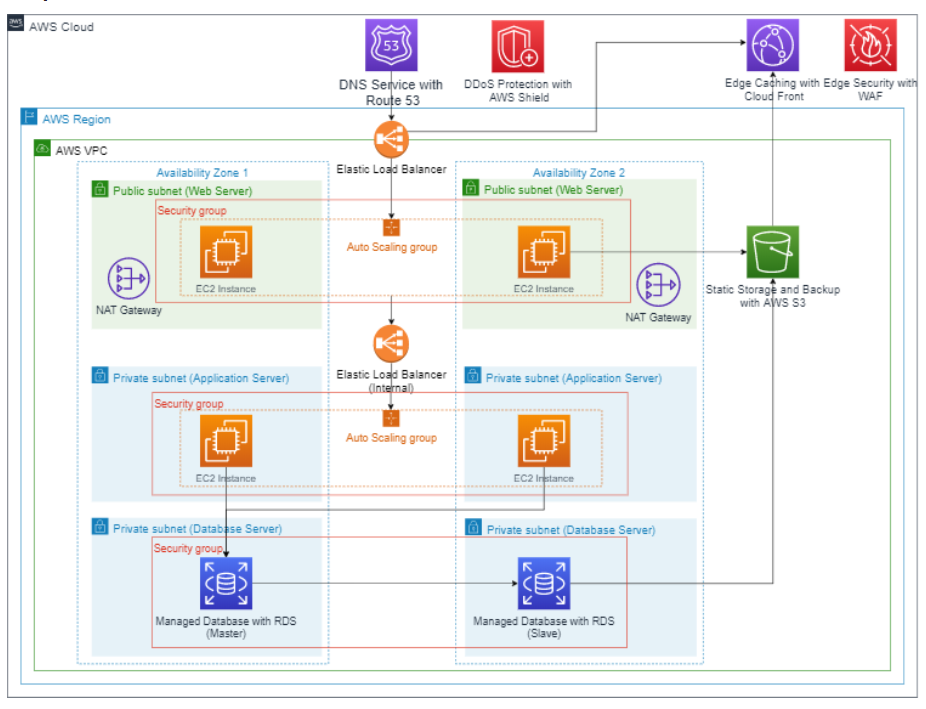AWS Web Server Hosting offers a robust and scalable platform for building and deploying web applications. By leveraging Amazon’s global infrastructure, you gain access to a wide range of services, including EC2 for virtual servers, S3 for object storage, Route 53 for DNS management, and CloudFront for content delivery.
These services work together to provide a comprehensive solution for hosting websites, applications, and APIs. Whether you’re a small startup or a large enterprise, AWS offers the flexibility and resources to meet your specific needs.
AWS EC2 for Web Server Hosting

Amazon Elastic Compute Cloud (EC2) is a fundamental service in AWS, offering virtual servers (instances) that provide the foundation for hosting various applications, including web servers. EC2 instances are highly customizable, allowing you to choose the right resources and configuration for your specific web server workload.
EC2 Instance Types, Aws web server hosting
EC2 instance types are designed for different workloads, each with its own characteristics in terms of CPU, memory, storage, and networking capabilities. Selecting the right instance type is crucial for optimizing performance, cost-effectiveness, and scalability.
- General Purpose Instances (T, M, and R series): These instances offer a balanced mix of CPU, memory, and storage, making them suitable for a wide range of web server workloads, including websites, web applications, and databases.
- Compute Optimized Instances (C, C5, and M5 series): These instances prioritize CPU power, making them ideal for CPU-intensive tasks like web servers with high traffic, complex applications, and data processing.
- Memory Optimized Instances (R, R5, and X1 series): These instances provide large amounts of memory, suitable for applications with high memory requirements, such as in-memory databases, caching, and large-scale data processing.
- Storage Optimized Instances (I, I3, and H series): These instances prioritize storage performance, making them suitable for workloads that require high throughput and low latency, such as databases, data warehousing, and content delivery.
- GPU Instances (G, G3, and P series): These instances are equipped with graphics processing units (GPUs), designed for workloads that require high-performance computing, such as machine learning, deep learning, and video processing.
Launching an EC2 Instance
Launching an EC2 instance involves a few key steps:
- Choose an Amazon Machine Image (AMI): An AMI is a template that defines the operating system, software, and configurations for your instance. AWS offers a variety of pre-built AMIs for popular operating systems and web server software, or you can create your own custom AMI.
- Select an Instance Type: Choose the instance type that best suits your web server workload, considering factors like CPU, memory, storage, and networking requirements.
- Configure Network Settings: Specify the network settings for your instance, including the subnet, security group, and Elastic IP address (if required).
- Set Storage: Choose the storage type and size for your instance, considering factors like performance, cost, and durability.
- Launch the Instance: Once you’ve configured all the settings, you can launch your EC2 instance.
Configuring an EC2 Instance for Web Server Hosting
After launching an EC2 instance, you need to configure it for web server hosting:
- Connect to the Instance: Use SSH (Secure Shell) to connect to your EC2 instance and access its command-line interface.
- Install Web Server Software: Install your preferred web server software, such as Apache or Nginx, using the appropriate package manager for your operating system.
- Configure Web Server: Configure the web server settings, including virtual hosts, document root, and access control.
- Deploy Your Website: Transfer your website files to the EC2 instance’s web server document root.
- Test and Monitor: Test your website to ensure it’s functioning correctly and monitor its performance and resource usage.
Popular Web Server Software
Apache and Nginx are two of the most popular web server software options:
- Apache: A mature and widely used web server, known for its stability and extensive feature set. It’s often used for traditional websites and web applications.
- Nginx: A high-performance web server, known for its efficiency and scalability. It’s often used for modern web applications, content delivery networks (CDNs), and reverse proxies.
Installing Web Server Software on EC2
Installing web server software on an EC2 instance is straightforward:
- Apache:
For Ubuntu/Debian:
sudo apt update
sudo apt install apache2For CentOS/RHEL:
sudo yum update
sudo yum install httpd - Nginx:
For Ubuntu/Debian:
sudo apt update
sudo apt install nginxFor CentOS/RHEL:
sudo yum update
sudo yum install nginx
Content Delivery Network (CDN) with AWS CloudFront

A Content Delivery Network (CDN) is a geographically distributed network of servers that cache and deliver web content to users based on their location. CDNs significantly enhance website performance and global reach by minimizing latency and improving user experience.
Configuring and Using CloudFront
AWS CloudFront is a powerful CDN service that allows you to deliver web content from a global network of edge locations. To configure and use CloudFront, you need to create a distribution, which defines the origin servers, cache behavior, and other settings for your CDN.
- Create a Distribution: In the CloudFront console, you’ll define the origin servers (e.g., your EC2 instance or S3 bucket) that will serve the content. You’ll also configure the cache behavior, such as which files to cache and for how long.
- Set Up a Custom Domain: You can use a custom domain name for your CDN, making it easier for users to access your content.
- Configure Access Control: You can restrict access to specific content using CloudFront’s access control features, such as origin access identity and signed URLs.
- Monitor and Analyze Performance: CloudFront provides detailed metrics and logs that you can use to monitor performance and identify areas for improvement.
Deployment and Management Tools
Deploying and managing your web server on AWS can be made significantly easier and more efficient with the use of various tools and automation. AWS offers a range of services and tools designed to streamline these processes, allowing you to focus on your application rather than the underlying infrastructure.
Deployment Tools
Using deployment tools for your web server on AWS offers several benefits, including faster deployment times, reduced errors, and improved consistency. Here are some popular deployment tools:
- AWS CodeDeploy: A fully managed deployment service that automates the deployment of your applications to AWS EC2 instances, AWS Lambda functions, or on-premises servers. It handles the entire deployment process, including traffic routing, rollback, and monitoring.
- Terraform: An open-source infrastructure-as-code tool that allows you to define and manage your AWS resources using a declarative language. You can use Terraform to create, update, and destroy your entire AWS infrastructure, including EC2 instances, security groups, load balancers, and more.
- AWS CloudFormation: A service that allows you to model and provision your AWS resources using templates written in JSON or YAML. CloudFormation templates define the resources you need and their configuration, enabling you to create and manage your infrastructure as code.
- Ansible: An open-source configuration management and orchestration tool that automates tasks across your infrastructure. You can use Ansible to deploy your web server, install software, configure services, and manage updates.
Advantages of Automation
Automating the deployment and management of your web server on AWS offers significant advantages:
- Reduced Errors: Automation minimizes human error by eliminating manual configuration steps and ensuring consistent deployments.
- Increased Speed: Automated deployments are significantly faster than manual deployments, allowing you to release new features and updates more quickly.
- Improved Consistency: Automation ensures that every deployment is identical, reducing the risk of inconsistencies and ensuring a consistent user experience.
- Enhanced Scalability: Automation allows you to easily scale your infrastructure up or down as needed, making it easier to handle traffic spikes and ensure high availability.
- Simplified Management: Automation simplifies the management of your web server by automating tasks like monitoring, backups, and security updates.
AWS Management Consoles and APIs
AWS provides various tools for monitoring and managing your web server, including:
- AWS Management Console: A web-based interface that allows you to access and manage all your AWS resources, including EC2 instances, security groups, load balancers, and more. You can use the management console to monitor your web server’s performance, access logs, and manage security settings.
- AWS APIs: AWS provides a comprehensive set of APIs that allow you to programmatically interact with AWS services. You can use the AWS APIs to automate tasks, integrate with third-party tools, and build custom management tools.
Real-World Examples and Use Cases

AWS has become a popular choice for businesses of all sizes, offering a robust and scalable platform for web server hosting. Numerous companies across various industries have successfully leveraged AWS to host their websites and applications, experiencing significant benefits in terms of performance, reliability, and cost efficiency.
Real-World Examples of Companies Using AWS for Web Server Hosting
This section explores several real-world examples of companies that utilize AWS for web server hosting, showcasing the diverse applications and benefits derived from the platform.
- Netflix: The streaming giant relies heavily on AWS for its global content delivery network (CDN), ensuring seamless video streaming to millions of users worldwide. AWS’s scalability and reliability are crucial for handling the massive traffic and diverse user demands associated with Netflix’s platform.
- Airbnb: This online marketplace for vacation rentals leverages AWS for its web server hosting, enabling it to manage a vast amount of data, process user requests, and deliver a smooth user experience. AWS’s flexibility and cost-effectiveness are essential for Airbnb’s dynamic growth and global expansion.
- Pinterest: This social media platform, known for its visual content, uses AWS to power its website and application, ensuring high availability and performance for its millions of users. AWS’s services, such as EC2 and S3, provide the necessary infrastructure and storage capacity to manage the platform’s growing content and user base.
Use Cases for AWS Web Server Hosting Across Different Industries
This section examines various industries where AWS web server hosting proves advantageous, highlighting specific use cases and the benefits derived from the platform.
- E-commerce: Online retailers, such as Amazon, utilize AWS for their web server hosting, ensuring high availability, scalability, and performance to handle peak traffic during sales events and holidays. AWS’s services, such as Elastic Load Balancing and Auto Scaling, provide the necessary infrastructure to manage fluctuations in traffic and ensure a seamless shopping experience.
- Financial Services: Financial institutions, including banks and investment firms, leverage AWS for their web server hosting, ensuring secure and reliable access to critical financial data and applications. AWS’s security features and compliance certifications meet the stringent requirements of the financial industry, protecting sensitive information and maintaining regulatory compliance.
- Healthcare: Healthcare providers, such as hospitals and clinics, utilize AWS for their web server hosting, enabling secure and efficient management of patient records, medical imaging, and other sensitive healthcare data. AWS’s compliance with healthcare regulations, such as HIPAA, ensures the protection of patient privacy and data security.
- Media and Entertainment: Media companies, such as studios and broadcasters, leverage AWS for their web server hosting, enabling them to stream video content, manage digital assets, and deliver a seamless user experience. AWS’s scalability and reliability are crucial for handling the massive bandwidth demands associated with media streaming and content delivery.
- Education: Educational institutions, including universities and schools, utilize AWS for their web server hosting, enabling them to provide online courses, manage student records, and facilitate remote learning. AWS’s cost-effectiveness and scalability are essential for supporting the growing demand for online education and the diverse learning needs of students.
Common Challenges and Solutions Related to Web Server Hosting on AWS
This section identifies common challenges encountered when hosting web servers on AWS and explores solutions to address these issues effectively.
- Security: Ensuring the security of web servers on AWS is paramount, as it involves protecting sensitive data and applications from unauthorized access and malicious attacks. AWS provides robust security features, such as security groups, IAM roles, and encryption services, to mitigate security risks and safeguard data.
- Scalability: Web servers hosted on AWS need to be scalable to handle fluctuations in traffic and user demands. AWS offers services such as Auto Scaling and Elastic Load Balancing, which automatically adjust resources based on real-time traffic patterns, ensuring optimal performance and availability.
- Cost Optimization: Managing costs associated with web server hosting on AWS requires careful planning and optimization. AWS provides tools and services, such as Cost Explorer and Reserved Instances, to help businesses track and control their cloud spending, ensuring cost efficiency.
- Performance: Optimizing web server performance on AWS is crucial for delivering a smooth user experience. AWS offers services such as CloudFront and EBS volumes, which enhance performance by caching content, reducing latency, and providing high-throughput storage.
- Management: Managing web servers hosted on AWS involves various tasks, such as monitoring, patching, and troubleshooting. AWS provides tools and services, such as CloudWatch and Systems Manager, to simplify management tasks, reduce manual effort, and ensure operational efficiency.
Best Practices for AWS Web Server Hosting
Optimizing your web server infrastructure on AWS involves a comprehensive approach that encompasses security, scalability, performance, and cost optimization. By implementing best practices, you can ensure high availability, reliability, and efficient resource utilization for your web applications.
Security
Security is paramount for any web server deployment, especially in a cloud environment. Here are some key practices to enhance security:
- Use Strong Passwords and Multi-Factor Authentication (MFA): Employ robust passwords and MFA for all user accounts, including administrative accounts, to prevent unauthorized access.
- Implement Security Groups and Network Access Control Lists (ACLs): Configure security groups and network ACLs to restrict inbound and outbound traffic, allowing only necessary connections.
- Enable Security Features: Leverage AWS security features such as AWS Shield, AWS WAF, and Amazon Inspector to detect and mitigate threats.
- Regularly Patch and Update Systems: Keep your operating system, software, and dependencies up-to-date with the latest security patches to address vulnerabilities.
- Implement Secure Configuration Management: Establish secure configuration management practices using tools like AWS Config to ensure compliance with security policies and best practices.
Scalability
Scalability is crucial for handling fluctuating traffic demands and ensuring a seamless user experience. Consider these practices:
- Use Auto Scaling Groups: Leverage AWS Auto Scaling to automatically adjust the number of instances based on predefined metrics, ensuring that your web server can scale up or down as needed.
- Optimize Instance Types: Select appropriate instance types based on your application’s requirements, balancing CPU, memory, and storage needs for optimal performance and cost-effectiveness.
- Design for Horizontal Scalability: Architect your application with a distributed architecture that allows for easy horizontal scaling by adding more instances.
- Utilize Load Balancers: Implement load balancers to distribute traffic evenly across multiple instances, improving performance and resilience.
Performance
Performance is critical for user satisfaction and business success. Here are some tips for enhancing web server performance:
- Optimize Application Code: Refactor your application code to reduce resource consumption and improve efficiency.
- Use Caching Mechanisms: Implement caching strategies, such as object caching with Amazon CloudFront or in-memory caching, to reduce server load and improve response times.
- Optimize Database Queries: Analyze and optimize database queries to minimize execution time and improve overall performance.
- Leverage Content Delivery Networks (CDNs): Utilize CDNs like AWS CloudFront to cache static content closer to users, reducing latency and improving delivery speeds.
Cost Optimization
Cost optimization is essential for managing cloud expenses effectively. Consider these practices:
- Use Reserved Instances: Purchase reserved instances for predictable workloads to enjoy significant cost savings.
- Utilize Spot Instances: Leverage spot instances for flexible workloads, where you can bid on unused EC2 capacity at discounted rates.
- Optimize Storage: Choose the most cost-effective storage options for your data, considering factors like access frequency and durability.
- Implement Resource Monitoring and Automation: Monitor resource usage and automate scaling and shutdown of unused instances to minimize unnecessary costs.
High Availability and Reliability
Ensuring high availability and reliability is crucial for continuous service delivery. Here are some best practices:
- Implement Redundancy: Use multiple Availability Zones (AZs) to distribute instances across geographically separate locations, minimizing the impact of outages.
- Utilize Load Balancers: Employ load balancers to distribute traffic across multiple instances, ensuring failover in case of instance failure.
- Enable Health Checks: Configure health checks to monitor the health of instances and automatically replace unhealthy ones.
- Implement Disaster Recovery: Develop a disaster recovery plan that includes backups and failover mechanisms to restore service in case of major incidents.
Wrap-Up
In conclusion, AWS Web Server Hosting provides a powerful and versatile platform for building and managing your online presence. By understanding the benefits of different AWS services, you can create a secure, scalable, and cost-effective infrastructure for your web applications. As you explore the possibilities of AWS, remember that continuous optimization and monitoring are crucial for maintaining optimal performance and reliability.




